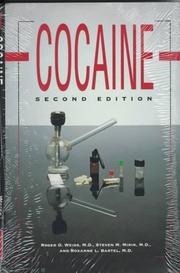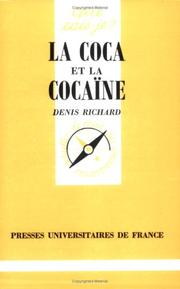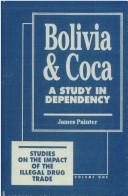| Listing 1 - 10 of 12 | << page >> |
Sort by
|

ISBN: 0880485493 Year: 1994 Publisher: London American psychiatric press
Abstract | Keywords | Export | Availability | Bookmark
 Loading...
Loading...Choose an application
- Reference Manager
- EndNote
- RefWorks (Direct export to RefWorks)
Cocaine abuse --- Cocaine --- Physiological effect
Book

Year: 1994 Publisher: Santa Monica, CA : RAND Corporation,
Abstract | Keywords | Export | Availability | Bookmark
 Loading...
Loading...Choose an application
- Reference Manager
- EndNote
- RefWorks (Direct export to RefWorks)
Gaps and inconsistencies in the picture of the cocaine trade increase the difficulty of making good choices about resource allocation and drug-fighting strategies. They also make it more difficult to evaluate the effectiveness of existing policies. This report documents a computer spreadsheet-based "systems description" for the cocaine trade that is a combination of database and analytical tool. Its structure allows users to substitute their own data or assumptions about parameters while preserving consistency or "conservation of mass" throughout the system. Three systems spreadsheets mirror the general pattern of the cocaine trade: production, international transportation, and U.S. distribution. In addition, a longitudinal database provides primarily production-related data from 1984 through 1990.
Cocaine industry --- Cocaine --- Statistics. --- Mathematical models. --- Processing
Book
Year: 1994 Publisher: Santa Monica, CA : RAND Corporation,
Abstract | Keywords | Export | Availability | Bookmark
 Loading...
Loading...Choose an application
- Reference Manager
- EndNote
- RefWorks (Direct export to RefWorks)
This report presents a simple equilibrium model of the cocaine industry in Peru, Bolivia, and Colombia. The purpose of the model is to represent the fundamental economic relations that determine the size of cocaine output and the price of cocaine, and to simulate the effects of policy initiatives or other changes in the surrounding environment. Model results indicate that: "crop substitution" programs will have a negligible impact on the world cocaine market. Cocaine supply control strategies that seize and destroy 70 percent or less of production, without limiting the total level of production, will have little impact on the market. Changes in the size of the world cocaine market have a relatively modest long-run impact on the standard of living of average workers in Peru, Bolivia, and Colombia.

ISBN: 0822314495 Year: 1994 Publisher: Durham ; London Duke University Press
Abstract | Keywords | Export | Availability | Bookmark
 Loading...
Loading...Choose an application
- Reference Manager
- EndNote
- RefWorks (Direct export to RefWorks)
Book
Year: 1994 Publisher: Santa Monica, CA : RAND Corporation,
Abstract | Keywords | Export | Availability | Bookmark
 Loading...
Loading...Choose an application
- Reference Manager
- EndNote
- RefWorks (Direct export to RefWorks)
This report describes how to construct time series for the price of cocaine using data from the Drug Enforcement Administration's System to Retrieve Information from Drug Evidence, a database that includes records of prices paid by undercover agents for individual purchases. Central to this process is the task of standardizing data for transaction size and purity. Prior efforts in this area are reviewed and their treatment of purity found wanting. This report suggests that because quality control is difficult for illicit products, price is governed more by the expected purity than by the actual purity of the product. Using this concept, price series are constructed for the gram, ounce, and kilogram level in a variety of locations. Analysis of these series reveals that significant price differences exist between cities, even at the wholesale level; these differences do not necessarily dissipate over time; and the ratio of prices at different market levels has remained remarkably constant over time. This last result is consistent with the hypothesis that price increases at one level are passed through to lower levels on a percentage basis (i.e., according to a multiplicative model) rather than a dollar-for-dollar basis (i.e., according to an additive model).
Cocaine --- Cocaine industry --- Prices --- Statistical methods. --- Government policy
Book
Year: 1994 Publisher: Santa Monica, CA : RAND Corporation,
Abstract | Keywords | Export | Availability | Bookmark
 Loading...
Loading...Choose an application
- Reference Manager
- EndNote
- RefWorks (Direct export to RefWorks)
This report documents the development of a two-state Markovian model of the demand for cocaine and includes the estimation of incidence, prevalence, cohort retention, and consumption. The Markovian model is required to fit (1) the overall prevalence data; (2) the fraction of all users who are heavy users in 1985, 1988, and 1990; and (3) the fraction of a cohort of initiates that is still using drugs ten years later, the ten-year cohort retention rate. The study states that the incidence of new users into light cocaine use has varied greatly over the years and is an input to the model; however, the model cannot predict future prevalence--it can only project prevalence given a hypothetical incidence scenario. The model also demonstrates that the fraction of all cocaine users who are heavy users has varied greatly over time, and that peak heavy usage followed peak incidence by about ten years. Consequently, the effect on heavy usage of government programs that reduce incidence (such as prevention programs) will only be realized many years later.

ISBN: 213046615X 9782130466154 Year: 1994 Volume: 2920 Publisher: Paris : PUF - Presses Universitaires de France,
Abstract | Keywords | Export | Availability | Bookmark
 Loading...
Loading...Choose an application
- Reference Manager
- EndNote
- RefWorks (Direct export to RefWorks)
Pharmacognosy --- Social problems --- Toxicology --- 582.751.6 --- Cocaine --- Coca --- Cocaine. --- Coca.

ISBN: 0822314916 0822396459 Year: 1994 Publisher: Durham : Duke University Press,
Abstract | Keywords | Export | Availability | Bookmark
 Loading...
Loading...Choose an application
- Reference Manager
- EndNote
- RefWorks (Direct export to RefWorks)
Carefully documenting the deceptions and excesses of television news coverage of the so-called cocaine epidemic, Cracked Coverage stands as a bold indictment of the backlash politics of the Reagan coalition and its implicit racism, the mercenary outlook of the drug control establishment, and the enterprising reporting of crusading journalism. Blending theoretical and empirical analyses, Jimmie L. Reeves and Richard Campbell explore how TV news not only interprets "reality" in ways that reflect prevailing ideologies, but is in many respects responsible for constructing that reality. Their examination of the complexity of television and its role in American social, cultural, and political conflict is focused specifically on the ways in which American television during the Reagan years helped stage and legitimate the "war on drugs," one of the great moral panics of the postwar era.The authors persuasively argue, for example, that powder cocaine in the early Reagan years was understood and treated very differently on television and by the state than was crack cocaine, which was discovered by the news media in late 1985. In their critical analysis of 270 news stories broadcast between 1981 and 1988, Reeves and Campbell demonstrate a disturbing disparity between the earlier presentation of the middle- and upper-class "white" drug offender, for whom therapeutic recovery was an available option, and the subsequent news treatment of the inner-city "black" drug delinquent, often described as beyond rehabilitation and subject only to intensified strategies of law and order. Enlivened by provocative discussions of Nancy Reagan’s antidrug activism, the dramatic death of basketball star Len Bias, and the myth of the crack baby, the book argues that Reagan’s war on drugs was at heart a political spectacle that advanced the reactionary agenda of the New and Religious Right—an agenda that dismissed social problems grounded in economic devastation as individual moral problems that could simply be remedied by just saying "no."Wide ranging and authoritative, Cracked Coverage: Television News, the Anti-Cocaine Crusade, and the Reagan Legacy is a truly interdisciplinary work that will attract readers across the humanities and social sciences in addition to students, scholars, journalists, and policy makers interested in the media and drug-related issues.
Television broadcasting of news --- Drug control --- Cocaine industry
Book
Year: 1994 Publisher: Santa Monica, CA : RAND Corporation,
Abstract | Keywords | Export | Availability | Bookmark
 Loading...
Loading...Choose an application
- Reference Manager
- EndNote
- RefWorks (Direct export to RefWorks)
This report analyzes the relative cost-effectiveness of various available drug interventions. Four such interventions analyzed in this document are (1) source country control; (2) interdiction; (3) domestic enforcement; and (4) treatment of heavy users. The first three of these programs focus on "supply-control," whereby the cost of supplying cocaine is increased by seizing drugs and assets and by arresting and incarcerating dealers and their agents. The fourth program is a "demand-control" program because it reduces consumption directly, without going through the price mechanism. This study states that an estimated $13 billion are being spent in the United States each year on the four drug programs listed above and that the bulk of those resources are spent on domestic enforcement. Treatment of heavy users has only a small percentage of this budget, even when privately funded treatment is included. Given the high cost of "supply control" programs, this report concludes that treatment of heavy users may be a more cost-effective way of dealing with drug interventions.
Cocaine industry --- Drug traffic --- Drug control --- Mathematical models. --- Mathematical models.

ISBN: 1555874908 9280808567 Year: 1994 Volume: 1 Publisher: Boulder : L. Reinner Publishers,
Abstract | Keywords | Export | Availability | Bookmark
 Loading...
Loading...Choose an application
- Reference Manager
- EndNote
- RefWorks (Direct export to RefWorks)
Cocaine industry --- Drug control --- Cocaïne --- Lutte antidrogue --- Industrie --- Bolivia --- Bolivie --- Economic policy --- Rural conditions --- Politique économique --- Conditions rurales --- Coca industry --- Cocaïne --- Politique économique --- Rural conditions.
| Listing 1 - 10 of 12 | << page >> |
Sort by
|

 Search
Search Feedback
Feedback About
About Help
Help News
News